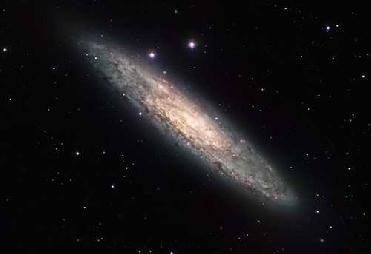
NGC 253 is one of the brightest spiral galaxies in the sky, and also one of the dustiest. ESO image
PARIS (BNS): Astronomers from the Instituto de Astrofísica de Canarias (Spain) using Very Large Telescope’s (VLT) acute and powerful near-infrared eye discovered a host of new young, massive and dusty stellar nurseries in nearby galaxy NGC 253. According to astronomers, the centre of this galaxy appears to harbour a twin of the Milky Way’s super massive black hole.
The astronomers said that using NACO, a sharp-eyed adaptive optics instrument on the European Space Organisation’s VLT they studied in depth NGC 253, one of the brightest and dustiest spiral galaxies in the sky. They said that Adaptive Optics (AO) corrects for the blurring effect introduced by the Earth’s atmosphere. This turbulence causes the stars to twinkle in a way that delights poets, but frustrates astronomers, since it smears out the images. With AO in action the telescope can produce images that are as sharp as is theoretically possible, as if the telescope were in space, the astronomers from the Spain institute said.
Scientists said that on observations they found that NACO revealed features in the galaxy that were only 11 light-years across. According to the lead author of the paper Juan Antonio Fernández-Ontiveros, the observations provided the much spatially resolved detail that for the first time will help compare them with the finest radio maps for this galaxy - maps that have existed for more than a decade.
Jose Antonio Acosta-Pulido, a member of the team said that these are probably very active nurseries that contain many stars bursting from their dusty cocoons. “NGC 253 is known as a starburst galaxy, after its very intense star formation activity. Each bright region could contain as many as one hundred thousand young, massive stars,” Acosta-Pulido said.
This comprehensive set of data also leads astronomers to conclude that the centre of NGC 253 hosts a scaled-up version of Sagittarius A*, the bright radio source that lies at the core of the Milky Way and which we know harbours a massive black hole. “We have thus discovered what could be a twin of our Galaxy's Centre,” co-author Almudena Prieto said.
Astronomers identified 37 distinct bright regions, a threefold increase on previous results, packed into a tiny region at the core of the galaxy, comprising just one per cent of the galaxy’s total size. The astronomers combined their NACO images with data from another VLT instrument, VISIR, as well as with images from the NASA/ESA Hubble Space Telescope and radio observations made by the Very Large Array and the Very Large Baseline Interferometer. Combining these observations, taken in different wavelength regimes, provided a clue to the nature of these regions.
 Next Article
Next Article











The Indian Air Force, in its flight trials evaluation report submitted before the Defence Ministry l..
view articleAn insight into the Medium Multi-Role Combat Aircraft competition...
view articleSky enthusiasts can now spot the International Space Station (ISS) commanded by Indian-American astr..
view article